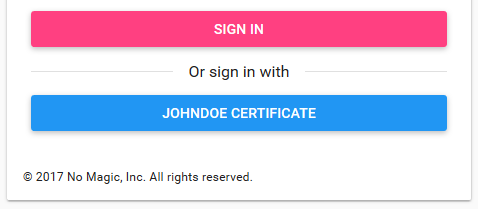On this page:
Basic Configuration
In order for Common Access Card (CAC) authentication to work, SSL must be enabled on the WebAppPlatform.
Next, you need to enable certificate authentication:
authentication.certificate.enabled=true
The next step is to configure which part of the subject DN (distinguished name) will be used as the username (authentication.certificate.username.template), and which part will be displayed in the login screen (authentication.certificate.displayname.template).
Both of these values default to using (CN)
Configure username
authentication.certificate.username.template=(CN)
The template can contain ASCII characters as well as placeholders in parenthesis that are replaced with relative distinguished name (RDN) values from the DN (if the username is constructed from the Subject Distinguished Name) or SAN (if the username is constructed from the Subject Alternative Name) .
For example, when the subject DN or SAN (of type 4) on the certificate is CN=JohnDoe,O=MyCompany,C=GB:
Template: (CN), username: JohnDoe
Template: (O)-(CN), username: MyCompany-JohnDoe
Template: CERT_(CN), username: CERT_JohnDoe
Configure the value displayed in the login button
To configure the value displayed in the login button, we must edit the authentication.certificate.displayname.template property:
authentication.certificate.displayname.template=(CN)
For example, as shown in the picture above, when the subject DN or SAN (of type 4) on the certificate is CN=JohnDoe,O=MyCompany,C=GB, and the display template is (CN) CERTIFICATE, the button will display „JOHNDOE CERTIFICATE“.
For a list of all the advanced properties available for configuration, please refer to Authentication by certificate.
TrustStore Configuration
CAC integration requires that a truststore containing the Certificate Authority (CA) certificates that issue the user's certificates would exist.
Certificate verification should be enabled in the WebAppPlatform/conf/server.xml file. See the Tomcat configuration information for it on this page. E.g., if the Tomcat SSL implementation is JSSE-based, you will need to add the following attributes to the SSLHostConfig property under Connector:
- certificateVerification with the value optional or required (if ONLY the certificate authentication is allowed).
- truststoreFile - path to the truststore file containing the CA certificates.
- truststorePassword - truststore password.
- truststoreType - e.g. "JKS" or "PKCS12".
Certificate Revocation List
The authentication server supports 2 methods of handling certificate revocation lists - via a URL, or via a local list stored in the file system. To enable this feature, uncomment either authentication.certificate.revocation.list.url or authentication.certificate.revocation.list.file, and point it to the location of the revocation list.
authentication.certificate.revocation.list.url=http://someserver.somedomain.com/revocation.lst authentication.certificate.revocation.list.file=/opt/local/revovcation.lst
Related pages
